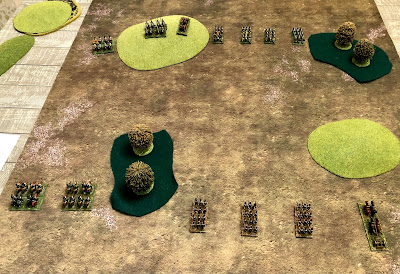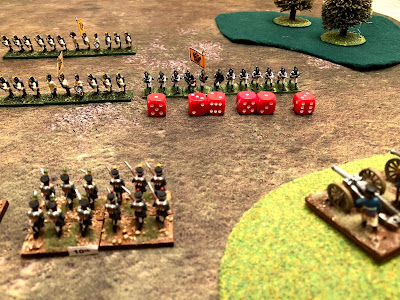Another symptom of wargamers disease is the never-ending search for the perfect ruleset. Chess has one set of rules - most wargamers have many shelves of them. Ever since Principles of War went out of fashion, I have been looking for a new set of tactical Napoleonic rules for my 15mm armies. Blucher works well for the big battles, and Black Powder is fine for my 28mm armies, but my 15's are gathering dust.
I tried the Bataille Empire rules last year, the Napoleonic version of ADLG. Not bad, but unnecessarily complex in places, and as a wargaming butterfly, I haven't the patience. I do like Blucher, so Sam Mustafa's new tactical rules for Napoleonics is worth a try. This is the 2nd edition of Lasalle. I didn't play the first edition so I can't compare. However, I understand it is a fundamental rewrite. I can see elements of Blucher and his WW2 rules Rommel in the game mechanics.
Units are battalion-sized (600+ men) or cavalry regiments (400-500 troopers) formed into brigades. A typical tabletop battle will have three or more brigades. A unit has four elements or two cannon, and there is no need to rebase because the movement is in base widths. You can use Blucher style labels for each unit or a roster sheet for keeping the unit statistics and recording strength levels.
The game starts by collecting Momentum points. These are used to give orders to units or brigades. The General marker can be used to gain additional Momentum or can intervene on the tabletop. I suspect it will be better to keep him on the table as the armies clash to make any quick formation changes such as forming a square. A Rommel style HQ sheet is used for each army to track. The active player is the one who wins an initial round of skirmishing. This is an interesting mechanism, which enables the better skirmishing army to go first, and it also gives the winner extra Momentum.
All the action takes place in the orders phase when you move, fire or charge your units. The amount of each depends on your Momentum points. Movement is pretty liberal, quick in the early stages, slowing up as you get near the enemy, and the same is true for formation changes. This speeds up the game a lot. Units can move in all the formations of the period, including line, march and mass for column and cavalry attacks. Squares don't move, which won't please my Russians fighting the Turks!
Each unit has a starting strength, which gets whittled down by firing and combat. You can try and rally strength points back but if you fail the strength point is lost. Each unit has a skirmish value, a resolve (morale) value, and sometimes extra traits. For example, firepower for British line, and weak fire for Janissaries. Both firing and combat mechanisms are pretty straightforward and quick. Artillery gets the bounce factor through lines of troops, so be careful with multiple lines. The non-active player can interrupt the active player if he has Momentum points, leading to the active player switching several times in a turn.
The rules are laid out in a similar way to Blucher and Rommel. Plenty of clear diagrams and examples. The design notes are included in the text, which I am not convinced is a good idea, particularly when using a PDF copy of the rules. There is a basic game and advanced rules that add additional complexity around doctrine, command traits and specialist units.
The army lists come in a free downloadable booklet, which cuts costs and allows for updating. Each country has a section with unit statistics, army options and a points system. As always with Sam's rules, they are well supported with downloadable playing aids, scenarios and a helpful forum. I am surprised that there is no list for the USA, although it shouldn't be too difficult to create one from the open architecture chapter. This will also be useful for those who care to indulge in ImagiNations.
For the tabletop test, I went for a small game set in 1809, Austrians v French. One infantry and one cavalry brigade on each side. Both infantry brigades enter the table in march column. You will also notice that artillery is deployed as a limber, which you take away and replace with cannon bases when deployed.
The French quickly change formation into mass (assault columns) and the Austrians get into line. This photo shows the initial firing dice, two for the centre bases and one for the outside ones.
Then the combat. You add up the remaining strength points for each unit and add the roll of one dice. There are only a few modifiers. There does seem to be an advantage in attacking as the main negative outcome for attackers is 'stagger' back. Although you can interrupt and charge right back. In most cases winning by 3 or more results in the defender being destroyed. This makes for quick and generally devastating combat outcomes.
My first impressions are very positive. These rules provide a fairly quick game for divisional level tactical games. After the read through and a couple of rounds, I shifted to the rule summary sheet. If you want more complexity the advanced rules provide that, but I will stick to the basic game for now. Looking forward to trying it out with bigger armies.





No comments:
Post a Comment